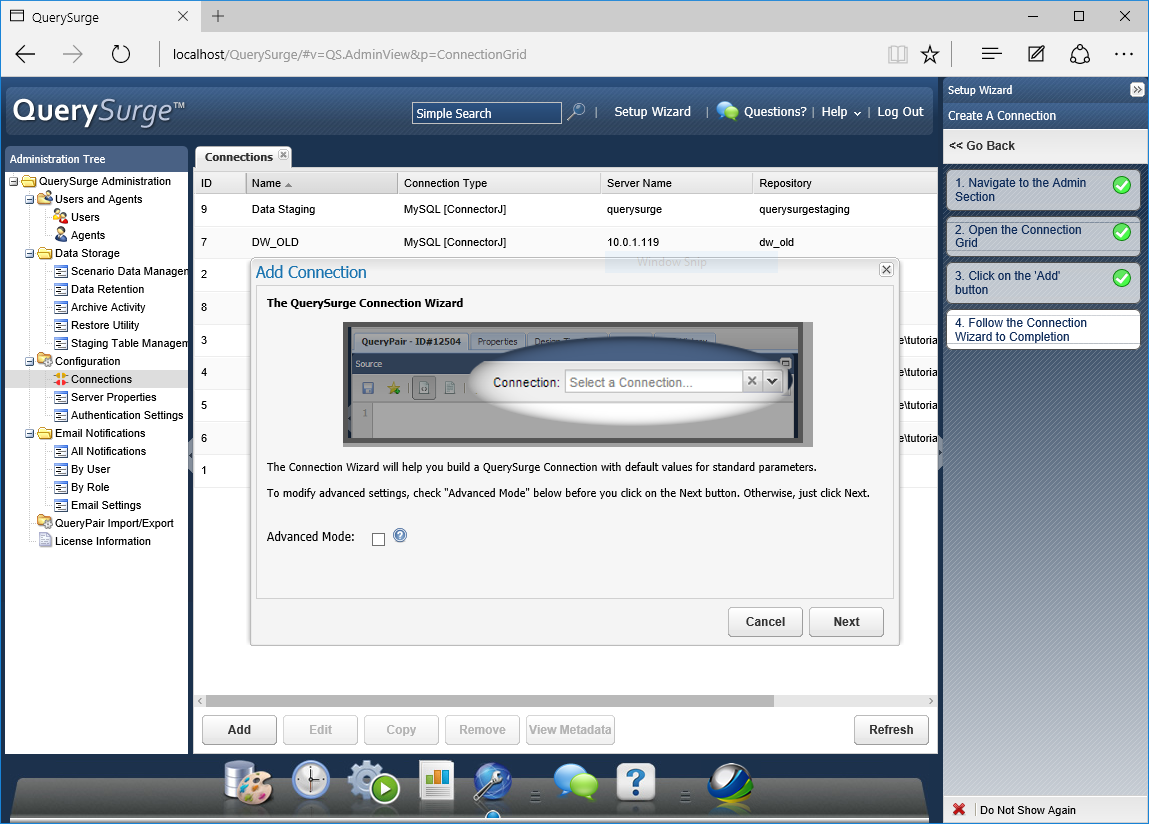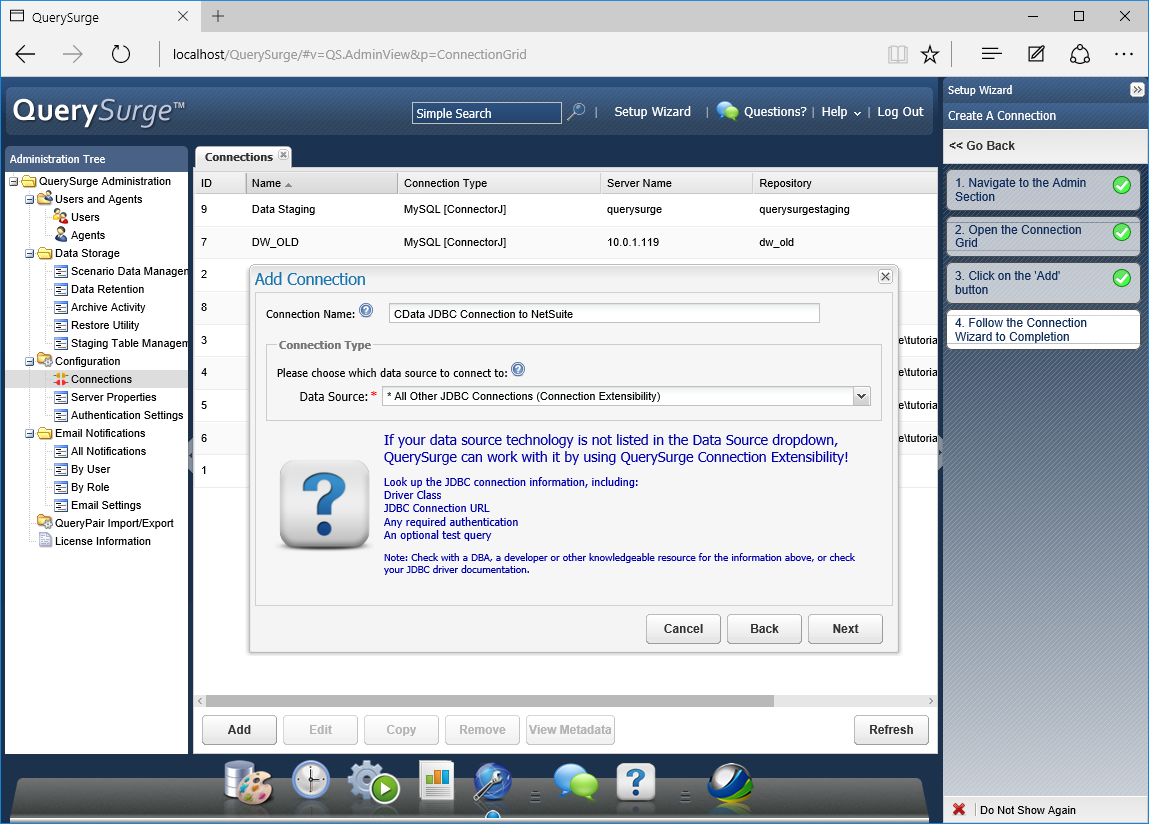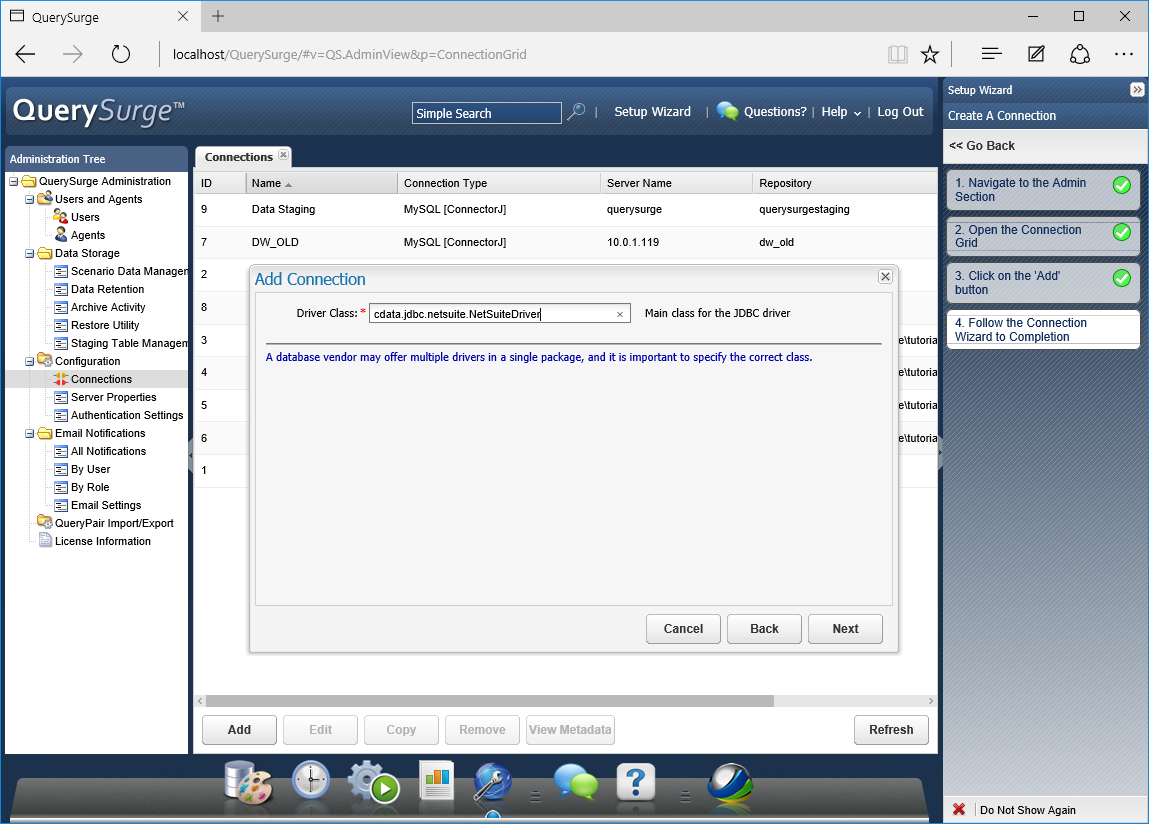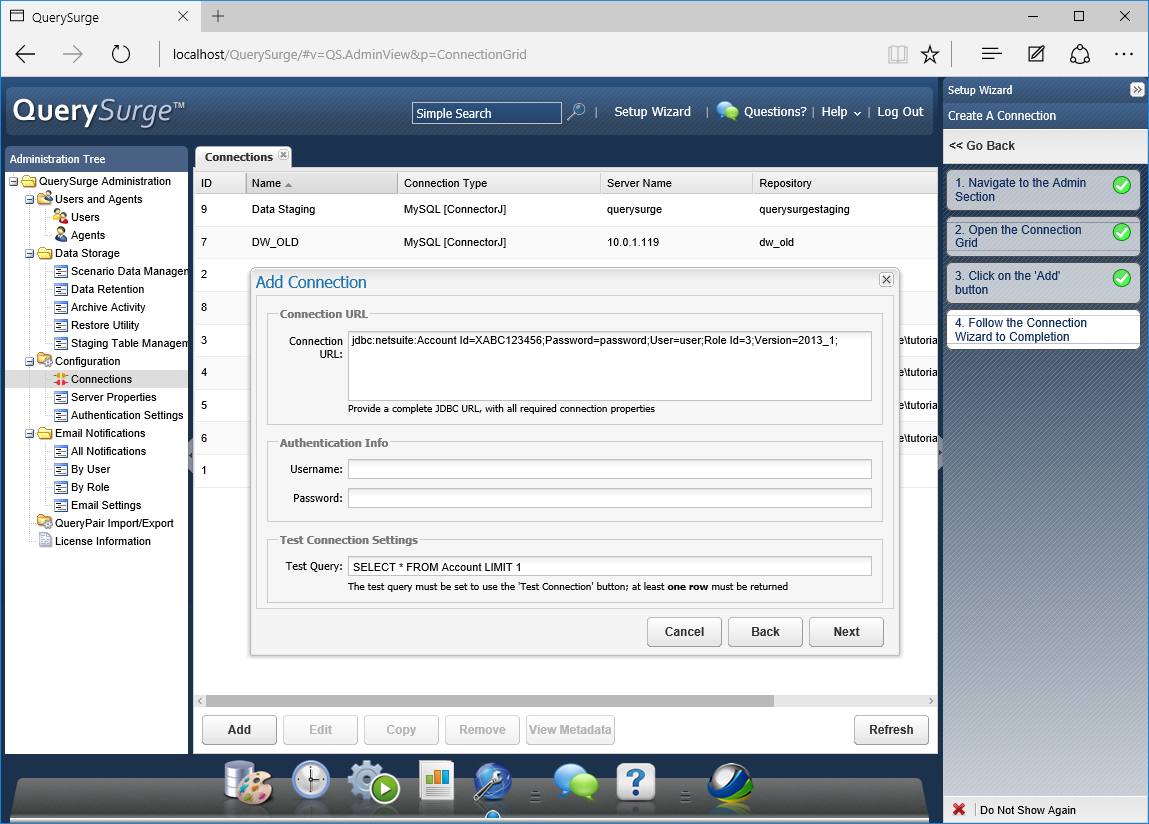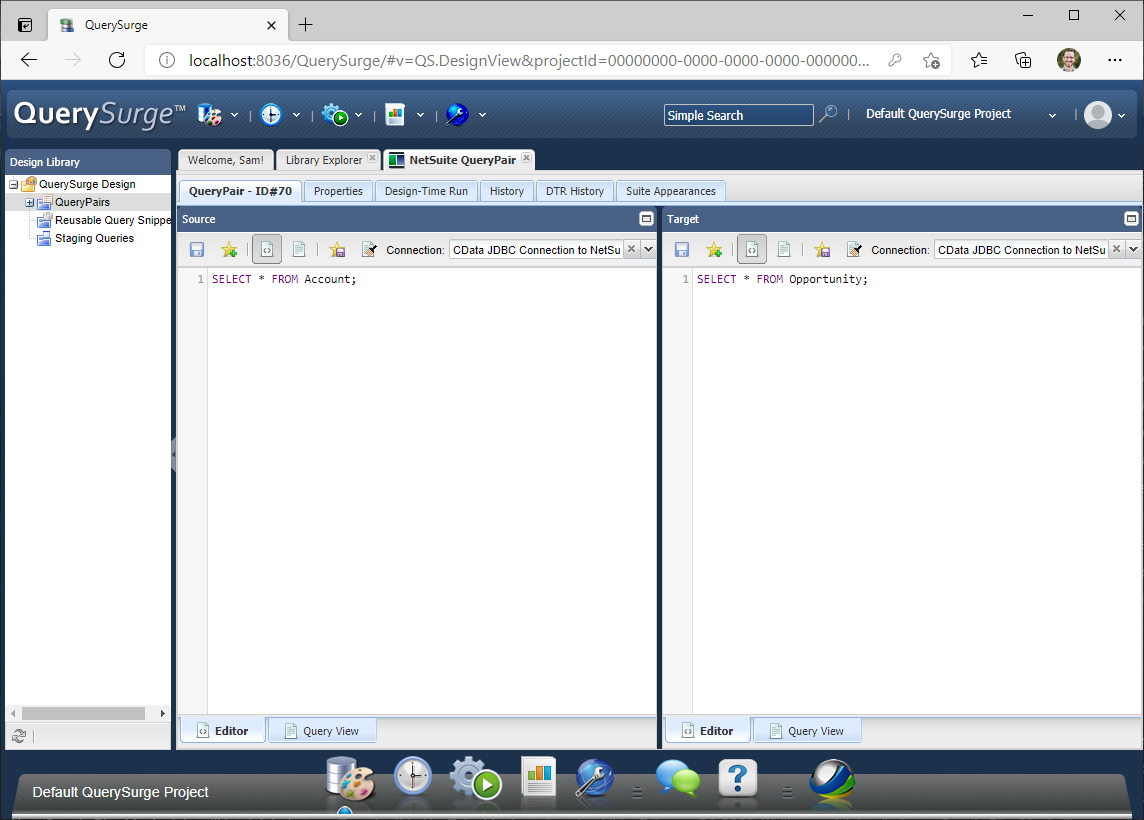Discover how a bimodal integration strategy can address the major data management challenges facing your organization today.
Get the Report →Validate Paylocity Data with QuerySurge
Access and validate Paylocity data in QuerySurge using the CData JDBC Driver.
QuerySurge is a smart data testing solution that automates data validation and testing. When paired with the CData JDBC Driver for Paylocity, QuerySurge can work with live Paylocity data. This article walks through connecting to Paylocity data from QuerySurge.
With built-in optimized data processing, the CData JDBC Driver offers unmatched performance for interacting with live Paylocity data. When you issue complex SQL queries to Paylocity, the driver pushes supported SQL operations, like filters and aggregations, directly to Paylocity and utilizes the embedded SQL engine to process unsupported operations client-side (often SQL functions and JOIN operations). Its built-in dynamic metadata querying allows you to work with and analyze Paylocity data using native data types.
Connecting to Paylocity Data in QuerySurge
To connect to live Paylocity data from QuerySurge, you need to deploy the JDBC Driver JAR file to your QuerySurge Agent(s) and add a new connection from the QuerySurge Admin view.
Deploy the JDBC Driver
- Download the CData JDBC Driver for Paylocity installer, unzip the package, and run the JAR file to install the driver.
- Once the driver is installed, stop the Agent Service.
- Copy the JAR File (and license file if it exists) from the installation location (typically C:\Program Files\CData\CData JDBC Driver for Paylocity\lib\) to your Agent(s) (QuerySurge_install_dir\agent\jdbc).
- Restart the Agent Service.
For more information on deploying JDBC drivers for QuerySurge, refer to the QuerySurge Knowledge Base.
Configure a New Connection to Paylocity
- Log into QuerySurge and navigate to the Admin view.
- Click Configuration -> Connections in the Administration Tree.
- Click Add to create a new connection.
- In the QuerySurge Connection Wizard, click Next.
![Creating a new connection]()
- Name the connection (e.g. CData JDBC Connection to Paylocity).
- Set the Data Source to "All Other JDBC Connections (Connection Extensibility)" and click Next.
![Naming the connection and choosing a Data Source]()
- Set the Driver Class to cdata.jdbc.paylocity.PaylocityDriver and click Next.
![Setting the Driver Class]()
Set the Connection URL using the necessary connection properties to authenticate with Paylocity. Your Connection URL will look something like the following:
jdbc:paylocity:OAuthClientID=YourClientId;OAuthClientSecret=YourClientSecret;RSAPublicKey=YourRSAPubKey;Key=YourKey;IV=YourIV;InitiateOAuth=GETANDREFRESH
Built-in Connection String Designer
For assistance in constructing the JDBC URL, use the connection string designer built into the Paylocity JDBC Driver. Either double-click the JAR file or execute the jar file from the command-line.
java -jar cdata.jdbc.paylocity.jarFill in the connection properties and copy the connection string to the clipboard.
Set the following to establish a connection to Paylocity:
- RSAPublicKey: Set this to the RSA Key associated with your Paylocity, if the RSA Encryption is enabled in the Paylocity account.
This property is required for executing Insert and Update statements, and it is not required if the feature is disabled.
- UseSandbox: Set to true if you are using sandbox account.
- CustomFieldsCategory: Set this to the Customfields category. This is required when IncludeCustomFields is set to true. The default value for this property is PayrollAndHR.
- Key: The AES symmetric key(base 64 encoded) encrypted with the Paylocity Public Key. It is the key used to encrypt the content.
Paylocity will decrypt the AES key using RSA decryption.
It is an optional property if the IV value not provided, The driver will generate a key internally. - IV: The AES IV (base 64 encoded) used when encrypting the content. It is an optional property if the Key value not provided, The driver will generate an IV internally.
Connect Using OAuth Authentication
You must use OAuth to authenticate with Paylocity. OAuth requires the authenticating user to interact with Paylocity using the browser. For more information, refer to the OAuth section in the Help documentation.
The Pay Entry API
The Pay Entry API is completely separate from the rest of the Paylocity API. It uses a separate Client ID and Secret, and must be explicitly requested from Paylocity for access to be granted for an account. The Pay Entry API allows you to automatically submit payroll information for individual employees, and little else. Due to the extremely limited nature of what is offered by the Pay Entry API, we have elected not to give it a separate schema, but it may be enabled via the UsePayEntryAPI connection property.
Please be aware that when setting UsePayEntryAPI to true, you may only use the CreatePayEntryImportBatch & MergePayEntryImportBatchgtable stored procedures, the InputTimeEntry table, and the OAuth stored procedures. Attempts to use other features of the product will result in an error. You must also store your OAuthAccessToken separately, which often means setting a different OAuthSettingsLocation when using this connection property.
![Using the built-in connection string designer to generate a JDBC URL (Salesforce is shown.)]()
- RSAPublicKey: Set this to the RSA Key associated with your Paylocity, if the RSA Encryption is enabled in the Paylocity account.
- Set the Test Query to enable the Test Connection button for the Connection (e.g. SELECT * FROM Employee LIMIT 1) and click Next.
![Setting the Connection URL and Test Query (NetSuite is shown)]()
- Click Test Connection to ensure the connection is configured properly and click Save to add the connection.
Once the connection is added, you can write SQL queries against your Paylocity data in QuerySurge.
Compare Paylocity Data Queries with a QueryPair
With the connection configured, you can follow the steps below to compare querying Paylocity data with a QueryPair.
- Select "Design Library" from the Design Menu
- Click QueryPairs under QuerySurge Design
- Click "Create New QueryPair"
- Name the QueryPair and click Save
- In either the Source or Target panes, select the connection created above (select the same connection to query Paylocity twice or another connection to perform a comparison)
- Write queries in the Editor for each pane, e.g. SELECT * FROM Employee
![Setting the Connection URL and Test Query (NetSuite is shown)]()
- Click the "Design-Time Run" tab to execute the queries
- When the query execution is finished, click "View Query Results" to see the Paylocity data returned by the query
![Setting the Connection URL and Test Query (NetSuite is shown)]()
Download a free, 30-day trial of the CData JDBC Driver for Paylocity and start working with your live Paylocity data in QuerySurge. Reach out to our Support Team if you have any questions.






